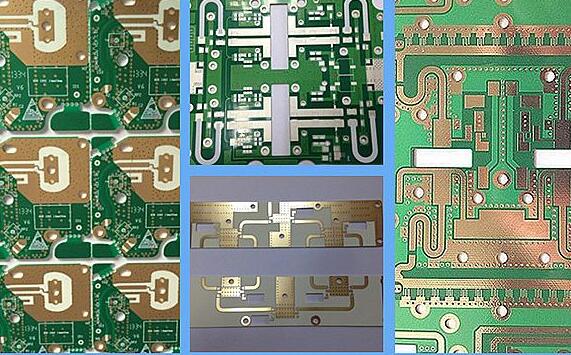High-frequency PCB circuit design engineersalso attach great importance to the parameter of intermodulation distortion (IMD). In passive circuits (such as antennas, cables and connectors), intermodulation distortion will also exist, that is, passive intermodulation (PIM). Quite simply, PIM will cause interference, and the generation of PIM is caused by the non-linearity in the passive circuit. Usually the transmitted signal is composed of the fundamental wave and its harmonic components. When two or more adjacent signals are transmitted at the same time, the non-linearity in the circuit will cause different signal harmonics to mix and generate additional spurious signals. These spurious signals can block or interfere with the reception of signals required by the receiver.
High-frequency circuit design Undesirable PIM products may be caused by several factors, including the amplitude and frequency of multiple signals transmitted, the structure of the circuit transmission line, and the current density and power level in the application. When there are multiple signals, they are usually described by their fundamental frequencies f1 and f2. The frequency of their PIM signal is generated by the different harmonics of the fundamental frequency signal.

It can be clearly seen that the frequency of the receiving channel is very close to the frequency of the transmitting channel, and it is very likely to be affected by high PIM products. The amplitude of the signal produced by PIM depends largely on the power level of the original signal. At the same time, it should be noted that this example only shows two signals and their second and third harmonics; if there are more fundamental signals and higher signal amplitudes, more harmonics are involved in the mixing process, resulting in PIM products will become more complex.
The impact of metals on PIM
The production of PIM is usually attributed to the quality of metal-to-metal contacts in wireless base stations and other communication systems (such as coaxial connector interfaces). In the system, such as the transmitter connector interface and other parts, due to the poor contact of the circuit interface, or the metal-to-metal inconsistency caused by dirt or oxidation on the metal surface and other forms of pollution, resulting in nonlinearity. When these poorly contacted or contaminated metal-to-metal surfaces are applied with voltages and have high current densities, their non-linearity will produce PIM products in the circuit.
Extensive research on circuit materials has shown that PIM is more caused by the circuit, assembly or system design, rather than due to the properties of the circuit material itself, such as dielectric constant and dielectric loss. Nevertheless, choosing an appropriate circuit material can help keep the PIM level low, and the key to reducing PIM is the metal surface in the design. A circuit board with a smooth copper foil surface with a copper-dielectric interface will exhibit lower PIM than a circuit board with a rough copper foil surface. Because of this material characteristic, designers looking for a printed circuit board (PCB) antenna with low PIM can choose a circuit laminate with minimal copper surface roughness at the copper-dielectric substrate interface.
Select RO4534™ circuit board from Rogers PCB baord to conduct some PIM experiments. Ro4350B is a low-PIM, antenna-level, high-frequency circuit laminate, with a low loss factor of 0.0027 at 10GHz, and a Dk value of 3.4±0.08. In order to explore the role of circuit materials in high-frequency PIM performance, three different types of microstrip circuits were designed on the same RO4534™ circuit laminate to compare how the difference in circuit structure on the same material affects PIM performance.
These three types of circuits are microstrip transmission lines, edge-coupled band-pass filters (BPF) and stepped impedance low-pass filters (LPF). The current density of the three circuits is different, and the PIM performance is also different. The microstrip transmission line with a minimum current density of 4.5 A/m has the lowest PIM of -157 dBc. BPF has a high current density of 23 A/m in its edge coupling part, and the PIM performance of the three circuits is the worst at -128 dBc. Between the two, the PIM performance of the LPF (12 A/m) whose current density falls between the microstrip transmission line and the BPF is also between the two other circuits, at -143 dBc.
Such a huge difference in PIM performance of circuits made from the same set of circuit board materials shows that the circuit is the cause of the difference in PIM, not the material. The difference in circuit structure has caused the difference in current density and the influence on the linearity of the circuit, resulting in the difference in PIM performance. For example, the simplest circuit-a microstrip transmission line-has the lowest current density and the best PIM performance. Essentially, a circuit that can achieve linear characteristics has excellent PIM performance, just as a circuit structure with lower linearity will have worse PIM performance, even if the same circuit material is used.
Although PIM is not a basic attribute of circuit materials, Rogers Corp. has been researching and analyzing the PIM performance of antenna-level circuit materials for quite some time (17 years). During this period, a large number of test result databases can help us deeply understand the circuits manufactured on these materials and the materials themselves, and help us better understand the effects of these materials and the signal power and current density on the performance of PCB PIMs, thereby helping Our customers develop low PIM PCB antennas and other passive circuit designs, such as filters. Therefore, Rogers’ antenna-grade materials, such as RO4534™ laminates, can provide consistent and predictable PIM performance in a broadband frequency range, enabling the design of a variety of circuit structures with the highest linearity.
Do you have any questions about high-frequency PCB circuit design or processing? The experts of ipcb company can provide you with relevant help.